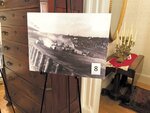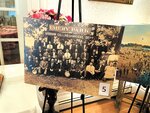By PAM SCHIFF
With a Cranston collaboration, the Sprague Mansion played host to the inaugural event of the Cranston Public Library and The Cranston Family Center’s night of Historic Cranston.
Led by Cranston librarian, Lisa Zawadzki, over a dozen people attended to learn about former famous Cranston landmarks and the history of Cranston, especially the library.
“People will come into the library all the time, and ask me what/where is this? So, I have to find out,” Lisa said.
Zawadzki used a slide show to present all the historical facts about Cranston.
In 1754 Cranston became a separate town after being a part of Providence for 116 years.
Roger Williams actually purchased the Cranston land from the Narragansett Indians in 1638.
According to Zawadzki historians have not been able to determine who exactly Cranston is named for. Many suspect it is for Samuel Cranston, the longest serving governor in Rhode Island. Or possibly Thomas Cranston, Speaker of the House and Samuel’s grandson.
One of the major highlights in Cranston’s history happened in the early morning hours of June 10, 1772. The burning of the H.M.S. Gaspee in Narragansett Bay, which actually ignited the Boston Tea Party.
The area that is now Knightsville, was originally named “Monkey Town”.
In 1807, the Cranston Print Works opens, and quickly becomes one of Cranston’s major employers.
At one time, there was a library branch inside the Cranston Print Works.
Where the current Stadium is, was the site of the former Narragansett Park, which opened in 1867.
“The Park had horse racing, auto racing, sporting events and was used as a State Fairgrounds,” said Zawadzki.
In 1867, the very first May Breakfast was held at the Oaklawn Church.
“In 1869, Cranston votes to transfer the Elmwood and South Providence neighborhoods to the City of Providence,” said Zawadzki.
The people who lived in those neighborhoods wanted access to all the city services that Providence provided at the time.
In 1872, Cranston saw the opening of the Rhodes on the Pawtuxet.
In the mid 1800’s, the State of Rhode Island purchases land to build several public institutions, such as poor houses, hospitals, farms, and the infamous boys’ school.
One of the most famous and long-lasting buildings in Cranston opened in 1890.
The Narragansett Brewery was a landmark until it closed in 1983.
“Everybody wither worked at the brewery, or they knew somebody who did,” joked Zawadzki.
Another major employer for Cranstonians, was the Maxwell-Briscoe Motor Company, located on the Eastern Side of the City at Wellington and Elmwood Avenues, from 1909-1913.
“The Maxwell Model Q was famous for it’s being a good value. Jack Benny joked that he had a Model Q,” said Zawadzki.
Another famous piece of history is the robot Gismo that was created by Cranstonian teenager Sherwood Fuhrer in 1956.
Fuehrer built Gismo the Peaceful from cans, gears, motors, die castings and other articles too numerous to mention. The robot —5 feet 11 inches tall and weighing 92 pounds—can hold a plate of cookies and pass them to guests.
The history of the Cranston Library is varied and consistent with the changing needs of the Cranston citizens, times and society.
According the Library web site, they have kept track of all important dates and changes.
- 1895 - The Arlington Library opens in October 1895 in the neighborhood district hall, as a result of months of hard work by the Arlington Public Library Association. The library opened with a collection of 500 volumes.
- 1896 - Oaklawn Library opens in a building that was formerly a school house.
- 1897 - The Edgewood Free Library opened on March 13, 1897 with a collection of 800 volumes in a small school at Park and Warwick Avenues. On November 4, 1897, the library moved into a new building on Norwood Avenue near Broad Street.
- 1907- The Arlington Library moves into a new building on Cranston Street. A branch was added in the Cranston Print Works Brick Store that flourished for at least 50 years until the building was razed.
- 1916 - William H. Hall died and left the residue of his estate to found a new library to replace the Edgewood Free Library.
- 1927 - The Knightsville Free Public Library was established by the Knightsville Library Association on November 8, 1926. The library opens in a store front on Cranston Street a year later on November 8, 1927.
- 1927 - On November 13, 1927 the William H. Hall Free Library opens to the public. The Hall Library was constructed on the 5 ½ acre Broad Street estate of its benefactor. The Georgian-style building of Indiana limestone on a granite base was designed by architect George Frederick Hall.
- 1932 - The Thornton Community Free Public Library opens in a store front. The library would move several times over its history to different locations on Plainfield Pike.
- 1957 - Construction begins on a new Colonial-style building for the Knightsville Library at 1847 Cranston Street. The building was constructed on land donated by the estate of Gerald Charles Ruggieri. The library opened on June 17, 1962 and remains in that location today.
- 1965 - The Cranston City Council commissioned a study by Kenneth Shaffer of Simmons College to craft recommendations for library development in the city. Based on the Shaffer report and in accordance with RI law, the City Council established the Cranston Public Library system in 1966. The six neighborhood libraries were invited to join.
- 1966 - On its 75th anniversary, a new edition was constructed to the Oaklawn Library.
- 1968 - Early in 1968, the Auburn and Oaklawn libraries become the first to join the newly established Cranston Public Library. James T. Giles was appointed the first Library Director in September 1968. In late 1968 the Thornton Library becomes the third library to join the new library system.
- 1969 - The Knightsville and Arlington libraries join the Cranston Public Library, in the Spring and Summer respectively.
- 1971 - The William Hall Library joins the library system, when the William Hall Library Trustees turn over operations of the Hall Library to the Cranston Public Library
- 1977 - The Thornton library branch is closed when the City Council refused to fund the $4,000 appropriation needed to run the facility.
- 1980s - The 1980s brought on a decade of major library development and renovation. The Central Library was opened in 1983 on Sockanosset Cross Road and became the administrative center of the library system. In 1989 the William Hall Library received an extensive and much needed renovation.
- 1986-1990 - Construction on the Cranston Senior Center begins. The Trustees agree to tear down the Arlington Library and turn over the land to the city provided that a library is always part of the Senior Center. The Arlington Reading Room opens as part of the new Center in 1990.
- 1990s - The wave of library development in Cranston continued in the early 1990s. The Oaklawn branch experienced expansion and renovation in 1990. A new Auburn branch building was constructed in 1991. An addition to the Central Library was completed in 1993. James Giles retired in 1995 after 26 years as Library Director. David Macksam was appointed Library Director in 1995.
- 2000s - The explosion of personal computers, the Internet and associated technologies saw major changes come to the library. CPL began offering free use of public computers and wireless Internet access. In 2006 an $900,000 bond initiative was passed to complete major infrastructure projects throughout the library system.
- 2010 – The Cranston Public Library Association is incorporated as a 501c3 non-profit to help support the Cranston Public Library with additional funding for programming and capital needs.
- 2012 - David Macksam retired as Library Director; Edward Garcia was appointed as CPL's third Library Director.
- 2013 - The Arlington Reading Room at the Cranston Senior Center is renovated using federal funds into the new Arlington Branch Library with new collections and updated technology.
- 2014 - A $1.2 million bond initiative is passed to complete major infrastructure projects throughout the library system.
- 2015 - "The C Lab" opens at the Central Library after a renovation of the reference department using funds from the Champlin Foundations. The C Lab is the library's multi-use digital media learning space. The Cranston Public Library was named “Library of the Year” by the University of Rhode Island Graduate School of Library and Information Studies (the inaugural presentation of the award). CPL also received the Mitzvah Award from the Holocaust Education and Resource Center of Rhode Island.
- 2016 - The Cranston Public Library is awarded the LibraryAware Community Award, Third Place. This national award recognizes model communities that engage with their libraries to improve the lives of their citizens and create life-long learners and library users. CPL was honored along with the Louisville (KY) Public Library and New York Public Library.
- 2017 - A renovated and enlarged children's room was opened at the Central Library. This two-year long project was the first enhancement to the children's room since the building opened in 1983. The new room is a whimsical space that features many areas for spontaneous reading and play. The renovation was completed with funds by the Champlin Foundation and City of Cranston Impact Fees. Library Journal featured the space in its “Library Architecture 2017” issue and the American Institute of Architects Rhode Island Chapter awarded the project their 2017 Merit Award.
- 2018 - In celebration of the 50th anniversary of the formation of the Cranston Public Library system; the meeting room at the Central Library was dedicated and renamed the James T. Giles Community Room in honor of the first Library Director James T. Giles. The Arlington library branch was dedicated and renamed The Edward Costa Memorial Arlington Branch in honor of longtime trustee and library advocate Edward Costa.
- 2020 - The library was awarded the 2020 Jerry Kline Community Impact Prize of $250,000 for its work in building community and recognized the library as a “vital community asset”. Cranston was only the second library to receive this national award along with the 2019 winner the Sacramento Public Library.
One very interesting activity you can do at the library is find the history of your home. With digitized property cards.
The Cranston library has all newspaper digitized, as well as almost every yearbook from Cranston high schools.
After the slide presentation, Zawadzki, passed out questionnaires with multiple choice answers about the assorted dozen photographs displayed throughout the room.
Each photograph was of a famous past or present location in Cranston.
To learn more about the Cranston Library, go to their web site, cranstonlibrary.org.
To learn more about the Cranston Historical Society and the Sprague Mansion, visit their Facebook page, https://www.facebook.com/cranstonhistoricalsociety/




Comments
No comments on this item Please log in to comment by clicking here